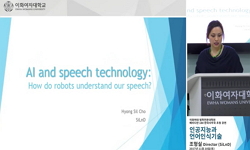This paper investigates whether listeners perceive a different level of politeness when the duration of the Korean sentence-final auxiliary particle ‘-yo’ is varied. A total of 10 Korean sentences were manipulated by lengthening and shortening ‘...
http://chineseinput.net/에서 pinyin(병음)방식으로 중국어를 변환할 수 있습니다.
변환된 중국어를 복사하여 사용하시면 됩니다.
- 中文 을 입력하시려면 zhongwen을 입력하시고 space를누르시면됩니다.
- 北京 을 입력하시려면 beijing을 입력하시고 space를 누르시면 됩니다.

보조사 ‘-요’의 음장 변화에 따른 청자의 지각 차이 비교 = A Comparative Study of Listener Perception of Durational Change in the Korean Auxiliary Particle ‘-yo’
한글로보기https://www.riss.kr/link?id=A100396393
- 저자
- 발행기관
- 학술지명
- 권호사항
-
발행연도
2011
-
작성언어
Korean
- 주제어
-
등재정보
KCI등재
-
자료형태
학술저널
-
수록면
55-62(8쪽)
-
KCI 피인용횟수
5
- 제공처
-
0
상세조회 -
0
다운로드
부가정보
다국어 초록 (Multilingual Abstract)
This paper investigates whether listeners perceive a different level of politeness when the duration of the Korean sentence-final auxiliary particle ‘-yo’ is varied. A total of 10 Korean sentences were manipulated by lengthening and shortening ‘-yo’ by 10%, 20%, and 30%. The participants included native Korean speakers and Chinese and Japanese learners of Korean (n=10, respectively). They were asked to rate the level of politeness of the stimuli on a 9-point scale. It was found that Korean listeners perceived decreased politeness as the duration of ‘-yo’ was shortened and increased politeness as it was lengthened. However, Chinese and Japanese listeners did not perceive a different level of politeness from the manipulated sentences. This finding suggests that it is important to teach L2 speakers that the duration of the auxiliary particle ‘-yo’ plays a role in Korean listeners’ perception of politeness.
참고문헌 (Reference)
1 이봉, "「ね」·「よ」에 대응하는 한국어 문말 형태에 관한 고찰" 한국일본언어문화학회 (14) : 217-235, 2009
2 이익섭, "한국의 언어" 신구문화사 1997
3 한재영, "한국어발음교육" 한림출판사 2006
4 이익섭, "한국어문법" 서울대학교출판부 2004
5 박기영, "한국어 학습자를 위한 한국어 종결어미의 억양 교육 방안 —특히 양태 의미에 따른 억양 차이를 중심으로—" 우리어문학회 (34) : 373-397, 2009
6 이희자, "한국어 학습용 어미·조사사전" 한국문화사 2001
7 김은애, "한국어 억양 교육을 위한 방법론적 고찰" 국제한국어교육학회 19 (19): 93-123, 2008
8 배덕희, "한국어 '-요', 일본어 '-ね'·'-よ'와 그 교육" 한국일본어문학회 (12) : 21-48, 2002
9 김지혜, "표준 중국어 경성의 음성, 음운학적 연구" 이화여자대학교 대학원 1999
10 권성미, "중국인 한국어 학습자의 중간언어에 나타나는 억양의 특성 연구-문두 강세구와 문말 억양을 중심으로-" 이중언어학회 (45) : 1-25, 2011
1 이봉, "「ね」·「よ」에 대응하는 한국어 문말 형태에 관한 고찰" 한국일본언어문화학회 (14) : 217-235, 2009
2 이익섭, "한국의 언어" 신구문화사 1997
3 한재영, "한국어발음교육" 한림출판사 2006
4 이익섭, "한국어문법" 서울대학교출판부 2004
5 박기영, "한국어 학습자를 위한 한국어 종결어미의 억양 교육 방안 —특히 양태 의미에 따른 억양 차이를 중심으로—" 우리어문학회 (34) : 373-397, 2009
6 이희자, "한국어 학습용 어미·조사사전" 한국문화사 2001
7 김은애, "한국어 억양 교육을 위한 방법론적 고찰" 국제한국어교육학회 19 (19): 93-123, 2008
8 배덕희, "한국어 '-요', 일본어 '-ね'·'-よ'와 그 교육" 한국일본어문학회 (12) : 21-48, 2002
9 김지혜, "표준 중국어 경성의 음성, 음운학적 연구" 이화여자대학교 대학원 1999
10 권성미, "중국인 한국어 학습자의 중간언어에 나타나는 억양의 특성 연구-문두 강세구와 문말 억양을 중심으로-" 이중언어학회 (45) : 1-25, 2011
11 최현정, "중국인 한국어 학습자의 강세 오류에 대한 실험음성학적 고찰을 통한 운율 교육 방안 연구" 고려대학교 2009
12 이지현, "종조사「ね」,「よ」의 一考察 -배려 측면에서의 오용을 중심으로-" 한국일본언어문화학회 (16) : 307-326, 2010
13 손인숙, "종조사 ねよ의 취급 실태 분석 : 제7차 교육과정 고등학교 일본어 교과서 를 대상으로" 영남대학교 2008
14 정명숙, "일본인과 중국인의 한국어 억양" 국제한국어교육학회 14 (14): 10-248, 2003
15 아카시 준이치, "일본어 終助詞의 기능에 관한 一考察" 명지대학교 2009
16 소재은, "일본어 終助詞わ와 よ에 관한 연구" 단국대학교 2010
17 양병곤, "이중모음의 음성학적 고찰" 동의대학교 21 : 19-36, 1994
18 최현정, "음절 길이 교육을 통한 중국인 학습자의 운율 오류 수정 효과 연구" 이중언어학회 (45) : 309-330, 2011
19 김정숙, "외국인을 위한 한국어 문법 2" 커뮤니케이션북스 2005
20 백봉자, "외국어로서의 한국어 문법 사전" 하우 2006
21 히카리 타카노리, "대우표현으로서의 종조사 ねよ의 기능과 용법에 대해서" 29 (29): 349-367, 1996
22 서정수, "국어문법" 한세본 2006
23 田中真一, "日本語の発音教室理論と練習" くろし出版 1999
24 정승미, "中國語 文尾 억양에 대한 實驗音聲學的 연구" 부산대학교 2010
25 Schiavetti, N, "The measurement of speech intelligibility, In Intelligibility in Speech Disorders" John Benjamins Co 1992
26 양병곤, "Praat Script를 이용한 음성분석과 변형" 만수출판사 2004
동일학술지(권/호) 다른 논문
-
- 한국음성학회
- 김미혜(Kim Mihye)
- 2011
- KCI등재
-
Articulatory Manifestation of Prosodic Strengthening in English /i/ and /ɪ/
- 한국음성학회
- Kim Sahyang
- 2011
- KCI등재
-
Word-Final Coda Acquisition by English-Speaking Children with Cochlear Implants
- 한국음성학회
- Kim Jungsun
- 2011
- KCI등재
-
Supralaryngeal Articulatory Characteristics of Coronal Consonants /n, t, th, t*/ in Korean
- 한국음성학회
- Son Minjung
- 2011
- KCI등재
분석정보
인용정보 인용지수 설명보기
학술지 이력
| 연월일 | 이력구분 | 이력상세 | 등재구분 |
|---|---|---|---|
| 2027 | 평가예정 | 재인증평가 신청대상 (재인증) | |
| 2021-01-01 | 평가 | 등재학술지 유지 (재인증) |  |
| 2018-01-01 | 평가 | 등재학술지 유지 (등재유지) |  |
| 2015-01-01 | 평가 | 등재학술지 유지 (등재유지) |  |
| 2011-01-01 | 평가 | 등재학술지 유지 (등재유지) |  |
| 2009-01-01 | 평가 | 등재학술지 선정 (등재후보2차) |  |
학술지 인용정보
| 기준연도 | WOS-KCI 통합IF(2년) | KCIF(2년) | KCIF(3년) |
|---|---|---|---|
| 2016 | 0.5 | 0.5 | 0.52 |
| KCIF(4년) | KCIF(5년) | 중심성지수(3년) | 즉시성지수 |
| 0.5 | 0.49 | 0.988 | 0.22 |




 ScienceON
ScienceON DBpia
DBpia



